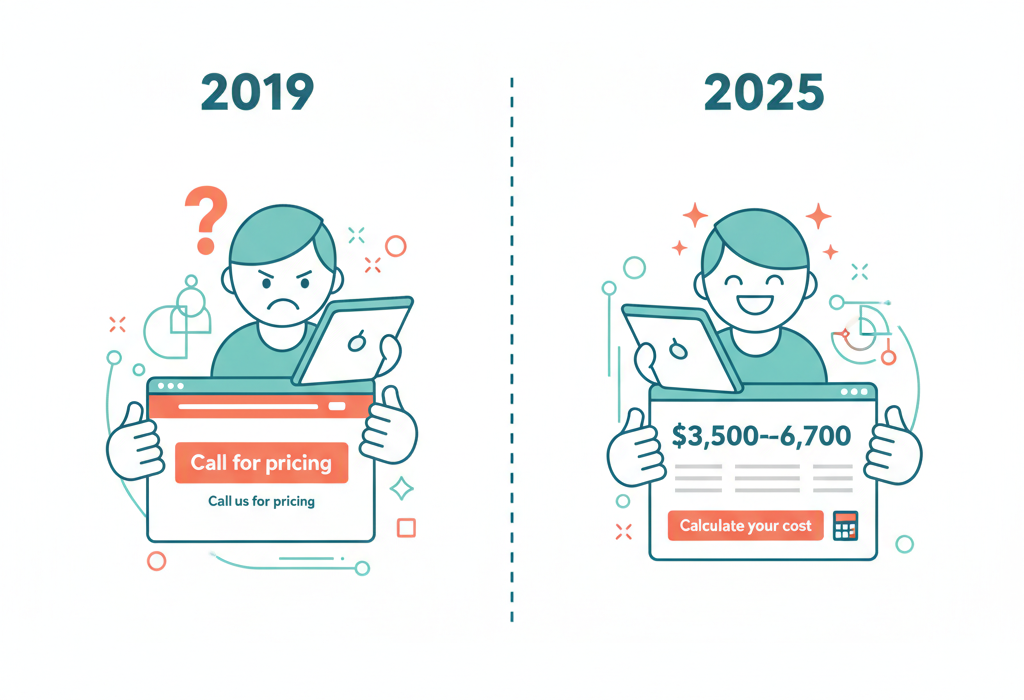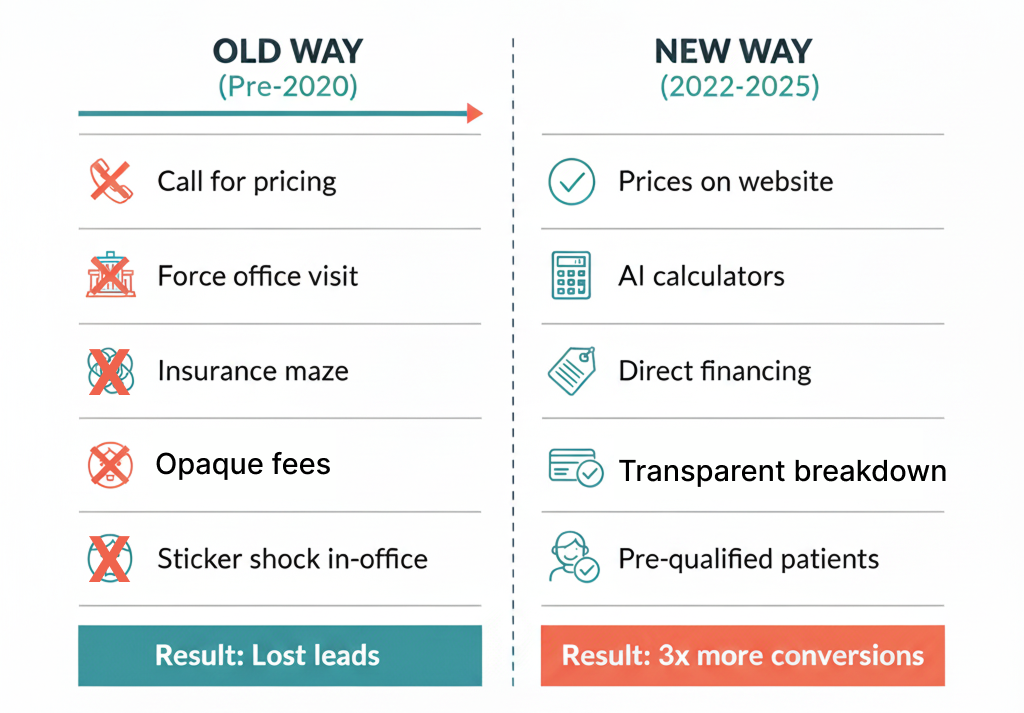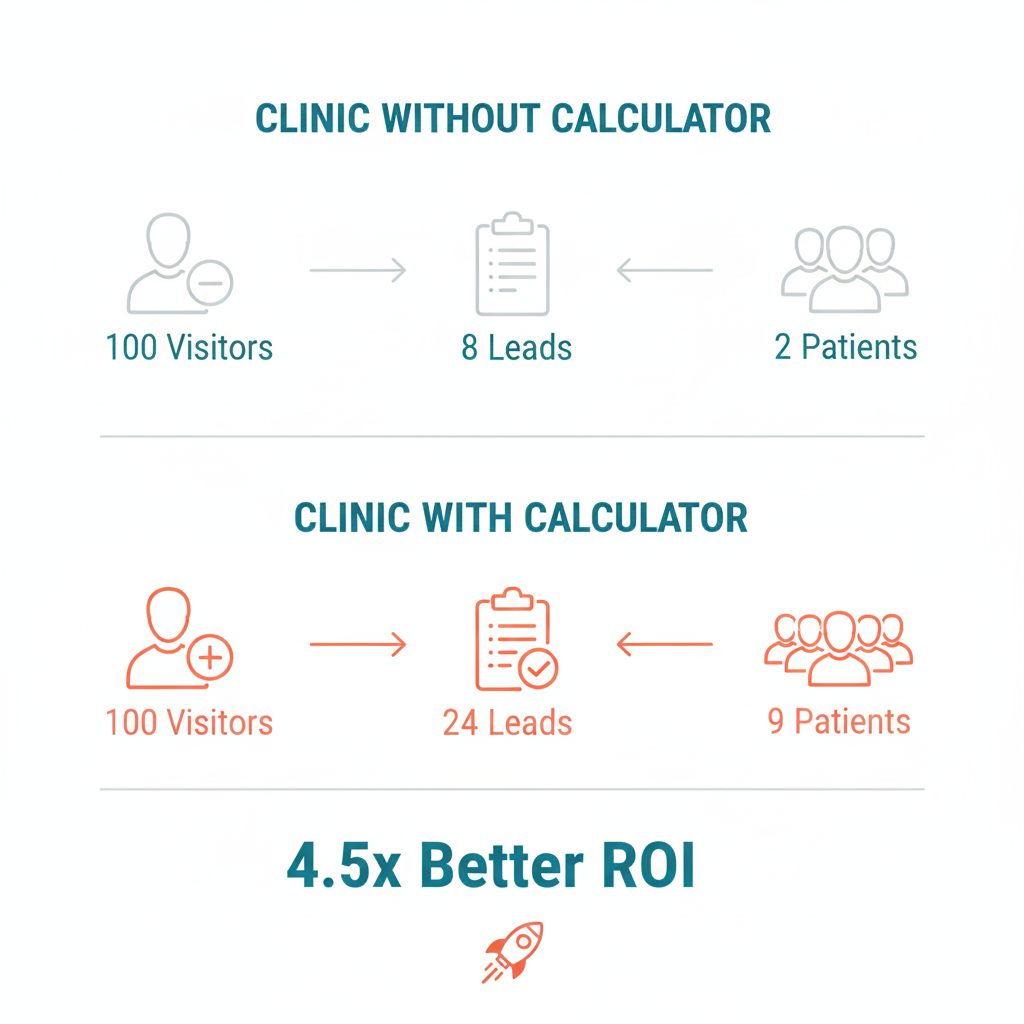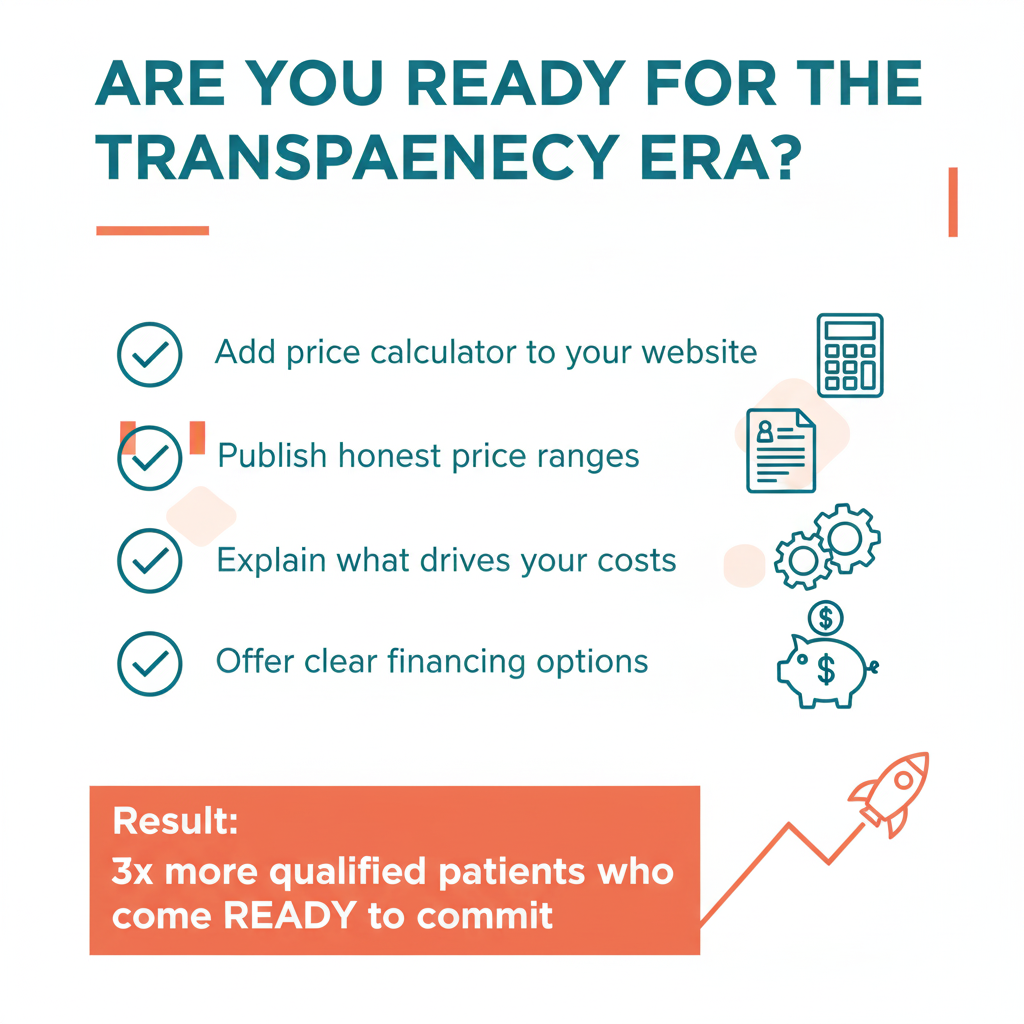The Fundamental Shift: Price Transparency – The New Trend in Dental Implant Marketing

Fig. 1: The digital era brings transparent pricing to dentistry – clinics publish implant costs online, allowing patients to easily compare options.
In recent years, dental implant marketing has undergone a fundamental transformation. Where treatment costs were once hidden until an in-person consultation, more and more clinics now openly publish fixed prices and fee schedules on their websites. Patients can now compare offerings from different centers at a glance – something that was practically impossible before. This shift toward price transparency marks a new era in the dental implant market. Below, we'll explore what has changed and why – from post-pandemic consumer behavior to competitive pressures and insurance influences – and what this means for practices and their marketing.
1. Post-Pandemic Changes in Consumer Behavior
After COVID-19, convenience became one of consumers' top priorities. People got used to buying everything – from clothing to groceries – online with one click. Dentistry was no exception: potential patients now thoroughly research dentists and clinics online before making treatment decisions. They expect the same price transparency as in any other industry. Indeed, today's patients typically search for implant cost information online before even calling a clinic, and search queries like "dental implant cost" have skyrocketed in recent years. Clinics that don't provide this information on their websites simply lose these sophisticated patients – they go to competitors who display prices openly.
Additionally, digital experience and service have become an integral part of expectations. According to industry experts, post-pandemic patients demand digital convenience – from online appointment booking to clear information about services and pricing. As Dental Products Report notes, the level of transparency and technology that people have become accustomed to in other sectors is now expected from healthcare services as well. As a result, clinics must adapt to a new generation of patients who value their time and money: openly discuss prices, offer online cost calculators, and so on. Transparency has become synonymous with patient care.
2. Competitive Pressure and Price Wars
The dental implant market is growing rapidly, intensifying competition between practices. Industry estimates project the U.S. dental implant market will grow from approximately $1.4 billion in 2023 to $3.7 billion by 2032 – an annual growth rate of about 11.4%. This explosive growth means fierce competition: more and more practices offer implantation, and they all need to attract patients. In this battle for clients, price transparency becomes a weapon. Patients are making a significant investment in their health by paying for implants – which means clinics must honestly and thoroughly discuss treatment costs. Implant placement requires substantial investment from the patient, as even patient education resources directly state. For example, on average, a single implant (including work and materials) costs thousands of dollars – a serious sum that people want to plan for in advance.
If previously you could simply hide the price "until consultation," now such tactics risk losing clients. Nearby competitors can offer the same service more clearly and transparently, immediately tipping the patient's choice in their favor. Moreover, price wars are emerging: some clinic chains are willing to publish aggressively low prices or detailed fee schedules, forcing others to catch up. Major players like Aspen Dental, for example, already openly advertise price ranges: $3,700–$6,100 for a single implant and $14,600–$29,900 for full-mouth restoration. When such industry giants bet on transparency, smaller practices must follow the trend or risk appearing suspiciously opaque to patients. Bottom line: in the wave of market growth, clinics that play honestly on the field of open pricing win.
3. Who Started the Trend: Pioneers of Price Transparency
A key pioneer of the new model was Nuvia Dental Implant Center around 2020–2022. This dental implant center network was among the first to openly discuss prices in their advertising and website. Nuvia put it bluntly: "Isn't it strange that so many implant clinics hide their prices? Without this information, patients can't move forward." The company featured this rhetorical question in their materials, essentially challenging the market's established rules.
Nuvia was first to publish a detailed online guide to implant pricing, breaking down what drives the cost, what options exist, etc. – information patients previously could only get at a consultation. This move immediately set Nuvia apart from competitors, increasing audience trust. Results came quickly: according to internal data, Nuvia clinics achieved a remarkable success rate in 2022–2024 – 99.13% successful implant integration/placement. Of course, this near-perfect success rate is primarily due to the high professionalism of doctors and quality of technology. But notably, Nuvia was able to attract a huge number of patients by making price transparency their competitive advantage. Simply put, price openness worked as a magnet for patients tired of treatment cost unpredictability elsewhere.
Today, Nuvia's approach is being adopted by other aggressive new players. For new clinics entering the implant market, it's easier to play by the new rules from the start than to try to defend the old model. Therefore, it was challenges from newcomers like Nuvia and similar centers that forced the entire industry to begin changing.
4. Deeper Reasons for the Shift: Failure of the Old Insurance Model
There are also structural reasons why price transparency has now become both possible and necessary. One of the main ones is the peculiarities of dental insurance and the dissatisfaction with it from both patients and progressive market players.
Ram Sudhireddy, CEO of Bento (a digital dental benefits platform), speaks bluntly on this subject. In his words, "dental insurance isn't really insurance." In regular health insurance, a person pays, say, $5,000 per year and has coverage for hundreds of thousands in case of serious illness. But in dentistry, a person pays ~$500 in premiums, and insurance covers a maximum of $1,000–$1,500 per year, and after exhausting this limit, the patient pays everything further out of pocket. "You can't call this insurance in the full sense – real insurance should bail you out in a catastrophe (house burns down, serious illness, etc.), but here – no," Sudhireddy explains. Essentially, dental policies look more like discount programs with payout limits. More than 95% of insured Americans never use their full annual dental insurance limit – the money stays with the insurer. For decades, insurance companies profited using this convoluted system of limits and coverage in which patients didn't fully understand what they were paying for.
However, the time of tolerance for such opacity has passed. Patients are tired of confusing bills and insurance restrictions – especially since they have to cover a significant portion of implant costs themselves anyway. New clinics have taken advantage of this patient frustration and essentially bypass the old insurance model. Instead of playing with paperwork and insurance policy fine print, they offer patients a clear fixed price for comprehensive service (for example, complete "turnkey" restoration for $XX thousand) and direct installment financing. Essentially, the "middleman" in the form of insurance is removed: patient and clinic directly agree on an acceptable price and payment plan. This benefits everyone – the patient feels control over expenses, and the clinic attracts more interested parties. It's no coincidence that at Nuvia, 92% of patients pay for implantation through convenient payment plans, bypassing classic insurance reimbursement.
Thus, the crisis of trust in insurance and digital solutions like Bento have cleared the way for a new transparent model. Insurance companies are transforming from the main barrier to price openness into an unnecessary link when the market dictates other rules.
5. Old vs. New School: How Implant Marketing Has Changed
For clarity, let's compare approaches "before" and "after" the price transparency era:
Old Model (before ~2020)
Refusing to Quote Prices Remotely: By old standards, clinic administrators were instructed to never quote costs over the phone. Patients were lured to appointments with phrases like: "Come in for a free consultation, the doctor will explain everything." Price was discussed only in person, in the office.
Selling Through Consultation: Without an in-person consultation – no cost information. It was believed that first you needed to convince the patient of the procedure's value, build trust, and only then communicate the price so that sticker shock wouldn't scare them away immediately.
Focus on Insurance Schemes: Marketing was built around the patient having insurance or a discount plan. The full cost wasn't discussed openly, the emphasis was: "We work with all insurance, we'll help with reimbursement" – meaning the patient was led through a maze of insurance compensations instead of straight talk about treatment cost.
Opaque Pricing: As a result, it was difficult for patients to know the final amount in advance. Fee schedules were either not published at all or contained fine print like "cost depends on the case." This allowed clinics to flexibly (and sometimes arbitrarily) adjust prices per patient, but undermined trust in the long term.

New Model (2022–2025)
Prices on the Website: Now fee schedules and price ranges are posted directly on clinic websites. Many create dedicated "Implant Cost" pages where they detail, for example: single implant – from $X to $Y, All-on-4 – approximately $Z per arch, etc. Patients can estimate the price range even before calling. Major chains started this trend, and now it's becoming the norm.
Interactive Price Calculators: Leading clinics go even further, implementing AI-powered cost calculators on their websites. Our experience working with over 50,000 leads shows that integrating such calculators increases conversion of website visitors into qualified leads by an average of 3x. Patients answer a few simple questions (how many teeth to restore, bone grafting needed, etc.) and receive a personalized cost estimate with breakdown. Such a tool not only demonstrates transparency but also pre-qualifies the lead – people who complete the calculator and leave contact information already understand the price range and are seriously committed to treatment.
Global Competition and Dental Tourism: Patients have realized they can save 30–70% by getting implants abroad, even accounting for travel. The emergence of open pricing has accelerated dental tourism: if a local clinic overprices, patients easily find an alternative in another country with lower prices online. This forces local players to keep prices fair and justified by quality.
Direct Competition Through Transparency: New marketing campaigns are built on slogans about "honest fixed prices, no hidden fees." Clinics openly compare their fees with competitors, competing on who offers the best value. Transparency has become a battleground for clients just as, for example, material quality or doctor qualifications were before.
Financing as Default Standard: Accessible payment plans and credit options are now offered by most clinics. For example, 92% of Nuvia patients close the deal using payment plans. This means marketing simplifies entry for the client: "Anyone can afford an implant – from $250/month on installments." Financing has ceased to be something out of the ordinary – rather it's an expected option immediately announced on the website.
6. Practical Impact: Educated Patients and New Marketing
Price transparency fundamentally changes patient behavior and clinic metrics. Let's look at specific numbers and consequences.
Today, the average cost of a single implant in the U.S. (including the implant itself, abutment, and crown) ranges from $3,500 to $6,700. This data is no longer secret – clinics openly list similar ranges in their fee schedules. And full "All-on-4" restoration (essentially, "teeth in a day" on 4 implants) costs approximately $24,000–$55,000 per arch. Previously, patients learned about these amounts after the fact, but now they're prepared: visiting a website, a person immediately sees the price range and can plan their budget or seek financing.

Price openness creates several consequences:
Pressure on Quality. When the market is transparent, clinics can no longer endlessly inflate prices without justification. Patients easily compare: "Here an implant is $4,000, and there $7,000 – why such a difference?" They'll have to explain what makes them superior – for example, surgeon experience, premium materials, lifetime warranty, etc. High price must be backed by high quality, otherwise the informed patient will choose a more advantageous offer. Transparency thus makes competition healthier: instead of price manipulation, the emphasis shifts to service quality and care.
More Educated, Ready Patients. Now a "savvy" patient comes to consultation who has already studied market rates and procedure details. They understand that, for example, an implant with work will be in the range of several thousand dollars, and are mentally (and financially) prepared for this. Such patients are higher-quality leads: they're seriously committed and pre-qualified, as the published price didn't scare them away. This increases conversion: according to marketing research data, if a person came after seeing the price on the website, the likelihood they'll start treatment is higher than a "random" visitor. Nuvia noted that conversion from consultation to actual treatment among "transparent" patients noticeably increased.
New Marketing Strategies = Trust and Lead Generation. Transparency has already proven its effectiveness as a trust-building tool. Clinics report that website pages with detailed price guides are among the most visited and rank well in search engines, attracting organic traffic. In advertising campaigns (targeting, contextual) stating prices also filters and attracts specifically "your" client: whoever sees the price and submits a request is highly likely your patient. Less time wasted on empty inquiries like "how much approximately does it cost?" Additionally, price openness increases loyalty: a patient who came through transparent advertising initially trusts the clinic more.
Conclusion: New Marketing Era – Transparency as Must-Have
Yes, we're truly witnessing a trend shift in the dental implant industry. From the old school of hidden prices and vague promises, the market is transitioning to the new school of openness and fair competition. Pioneers were aggressive innovators like Nuvia, who from 2020–2022 began using price transparency as a weapon against conservative competitors.
Why did this happen now? Several factors converged: rapid market and competition growth, digitalization and new patient behavior after COVID, frustration with the old insurance model where policies don't cover real expenses. Add to this technological capabilities (user-friendly websites, online calculators, payment apps) – and you have the ground for transformation. Price transparency has transformed from an option into a necessity.
This is exactly what we do – we help implant clinics implement AI-powered price calculators that transform simple website visitors into qualified patients. Having processed over 50,000 leads, we've identified a clear pattern: clinics with integrated calculators receive 3x more quality inquiries, and their patients come to consultations already informed and ready for treatment. This approach doesn't just increase conversion – it completely changes the quality of communication between clinic and patient, reducing the number of "empty" consultations and increasing the percentage of patients who actually begin treatment.
For practice owners and dental marketers, this is a golden window of opportunity. What yesterday was a "feature" of progressive centers today becomes the standard of expectations. Implement cost calculators on your websites, publish honest price ranges, explain what drives implant costs – this isn't just following fashion, but a critically important factor in your business conversion and success! Transparency builds trust, and trust leads patients directly to you. In other words, honesty is the best marketing strategy in dentistry's new era 🎯.
